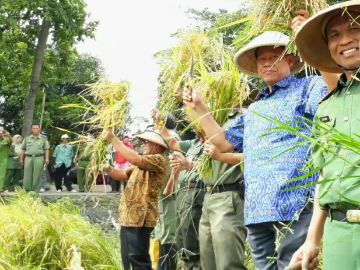Siapa Bilang Paceklik? Momon Rusmono Buktikan di Cirebon, Panen Padi Tiap Hari
Indonesia Managed to overcome Rice Harvest Failed
Editor : M. Achsan Atjo
Translator : Dhelia Gani

MASA PACEKLIK di penghujung tahun kerap ditandai dengan meningkatnya curah hujan Oktober hingga Desember, namun yang terjadi saat ini malah sebaliknya di Kabupaten Cirebon, Jawa Barat seperti disaksikan oleh Kepala Badan Penyuluhan dan Pengembangan SDM Pertanian (BPPSDMP) Kementerian Pertanian, Momon Rusmono saat panen padi di Desa Sitiwinagun, Kecamatan Jamblang pagi ini, Kamis (20/12).
Pada musim paceklik 2017 ini, produksi padi di Kabupaten Cirebon mampu menyediakan beras untuk memenuhi konsumsi masyarakat setempat sehingga pasokan beras melampaui kebutuhan konsumen dengan harga terjangkau.
Kepala Dinas Pertanian Kabupaten Ali Efendi mengatakan realisasi tanam September 2017 menghasilkan panen pada Desember 2017 seluas 2.367 hektar dengan produktivitas 5,7 ton per hektar, dan hasilnya 13.492 ton gabah kering giling (GKG) setara 8.526 ton ton beras. Hasil panen kumulatif sampai November mencapai 477.383 ton GKG atau setara 310.782 ton beras dan bila dijumlahkan dengan hasil produksi Desember mencapai total 318.967 ton beras. Sementara kebutuhan konsumsi kabupaten sekitar 257.651 ton beras.
“Kebutuhan konsumsi di Cirebon hanya 257.651 ton beras per bulan. Artinya, kebutuhan beras tercukupi malah surplus 61.316 ton,” kata Ali Efendi.
Momon Rusmono mengatakan terjaminnya produksi padi Kabupaten Cirebon lantaran sinergi pemerintah pusat dan daerah untuk terus menjamin bahkan meningkatkan produksi padi. Misalnya, untuk mengantisipasi dampak paceklik, pemerintah telah menyalurkan bantuan cukup banyak ke petani seperti pompa air, mesin traktor, benih berkualias, rehabilitasi jaringan irigasi tersier, embung dan lainnya.
“Pendampingan dan terjun ke lapangan oleh penyuluh pertanian dilakukan secara masif untuk memantau perkembangan tanaman untuk memastikan proses produksi berjalan lancar,” katanya.
“Dulu ketika musim paceklik seperti ini, produktivitas hanya lima ton per hektar. Terima kasih pada program pemerintah pusat, hasil panen lebih bagus,” kata Amin, petani di Desa Sitiwinangun.
Konsumsi Beras
Sebagaimana diberitakan, data Kementan menyebutkan luas tanam padi nasional pada Juli - September 2017 mencapai 1,0 - 1,1 juta hektar per bulan. Ini berarti naik dua kali lipat dari tahun sebelum ada program Upsus Pajale hanya 500.000 hektar per bulan.
Kepala BPPSDMP Kementan Momon Rusmono mengatakan dengan mengacu pada laporan Pusat Data dan Informasi Pertanian menyebut bahwa total luas panen padi nasional untuk Desember 2017 diperkirakan 1,1 juta hektar dengan hasil enam juta ton gabah kering giling setara tiga juta ton beras.
"Hasil produksi padi diperkirakan dapat memenuhi kebutuhan konsumsi beras nasional 2,6 juta ton, sehingga ada kelebihan atau surplus 0,4 juta ton," katanya.
Peningkatan luas tanam musim kering Juli - September naik dua kali lipat merupakan solusi permanen dari dampak Program Upsus Menteri Pertanian Andi Amran Sulaiman setelah merampungkan rehabilitasi jaringan irigasi tersier 3,4 juta hektar atau 113%, pembangunan 2.278 unit embung/dam parit/long storage, perluasan dan optimasi lahan 1,08 juta hektar, pengembangan lahan rawa 367.000 hektar, mekanisasi didukung alat mesin pertanian (Alsintan) rice transplanter dan combine harvester sebanyak 284.436 unit atau naik 2.175% dari 2014. Kemudian, bantuan benih 12,1 juta hektar, pupuk bersubsidi 27,64 juta ton dan asuransi usahatani padi 1,2 juta hektar.
RICE HARVEST failed at the end of the year in Indonesia is often characterized by increasing rainfall October to December, but what happened today is just opposite as in Cirebon district of West Java province, as witnessed by senior official of the agriculture ministry, Momon Rusmono during richectares in December 2017, productivity 5.7 tons per hectare and the realization of rice harvest 13,492 tons of dried milled grain or equal to 8,526 tons of rice.
Cirebon rice consumption needs only 257,651 tons per month, that means the need for rice is sufficient even surplus 61,316 ton," he said.
Mr Rusmono as the Director General of Agricultural Extension and Development of Agricultural Human Resources, or BPPSDM said the Cirebon rice harvest is a synergy between central and local government to increase rice production. For example, to anticipate the impact of crop failure, the government provides assistance to farmers such as water pumps, tractor engines, seedlings, tertiary irrigation rehabilitation, basin retention and others.
Farmer assistance is done massively to monitor the development of plants, to ensure production runs smoothly," he said.
Amin from the Sitiwinangun farmer group acknowledging the support of the government is very helpful such as water pump unit, seeds and hand tractor so that rice harvest produces 5.7 tons per hectare.
The productivity of last year´s rice harvest was only five tons per hectare. Thanks to the central government program, the harvest is better," he said.
Rice Consumption
As reported, the ministry data states that the national rice cultivation area from July to September 2017 reaches 1.0 - 1.1 million hectares per month or doubled before there is a special program, rice production is only 500,000 hectares per month.
Mr Rusmono said with reference to the Agricultural Data and Information Center or the Pusdatin report that the total area of national rice harvest for December 2017 estimated 1.1 million hectares, which produces 6 million tons of dry grain or equivalent 3 million tons of rice.
Rice production is estimated to meet the national rice consumption requirement of 2.6 million tons, so there is a surplus of 0.4 million tons," he said.
Increased planting area of dry season July to September as permanent solution of Agriculture Minister Andi Amran Sulaiman after rehabilitation of tertiary irrigation 3.4 million hectares or 113%, development of 2,278 units of ditch/long storage, expansion and optimization of 1.08 million hectares of land, 367,000 hectares of swampland development, mechanization by agricultural machinery rice transplanter and combine harvester 284,436 units or up 2.175% from 2014. Then, seed aid 12.1 million hectares, subsidized fertilizer 27.64 million tons and insurance of rice farming 1.2 million hectares.















